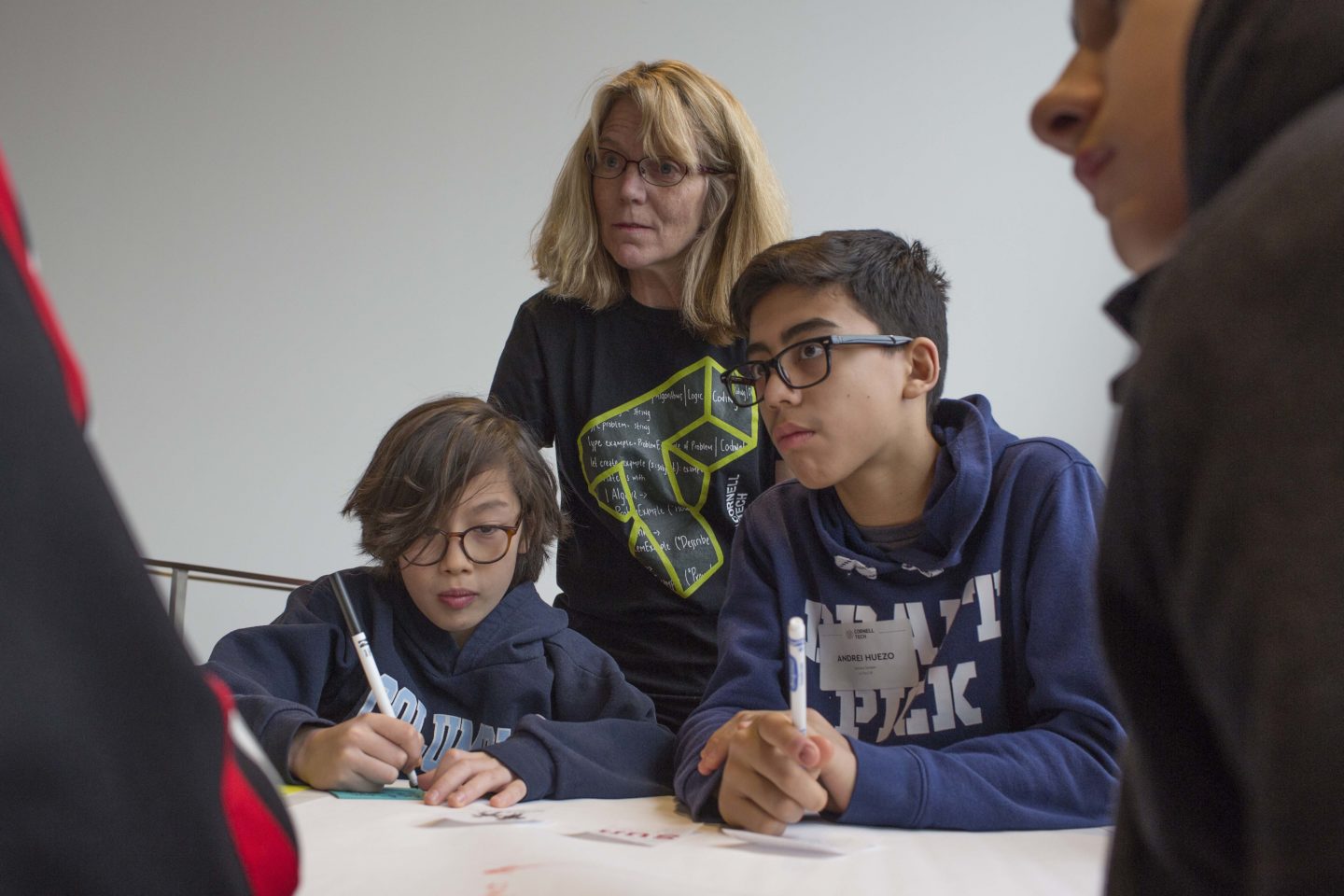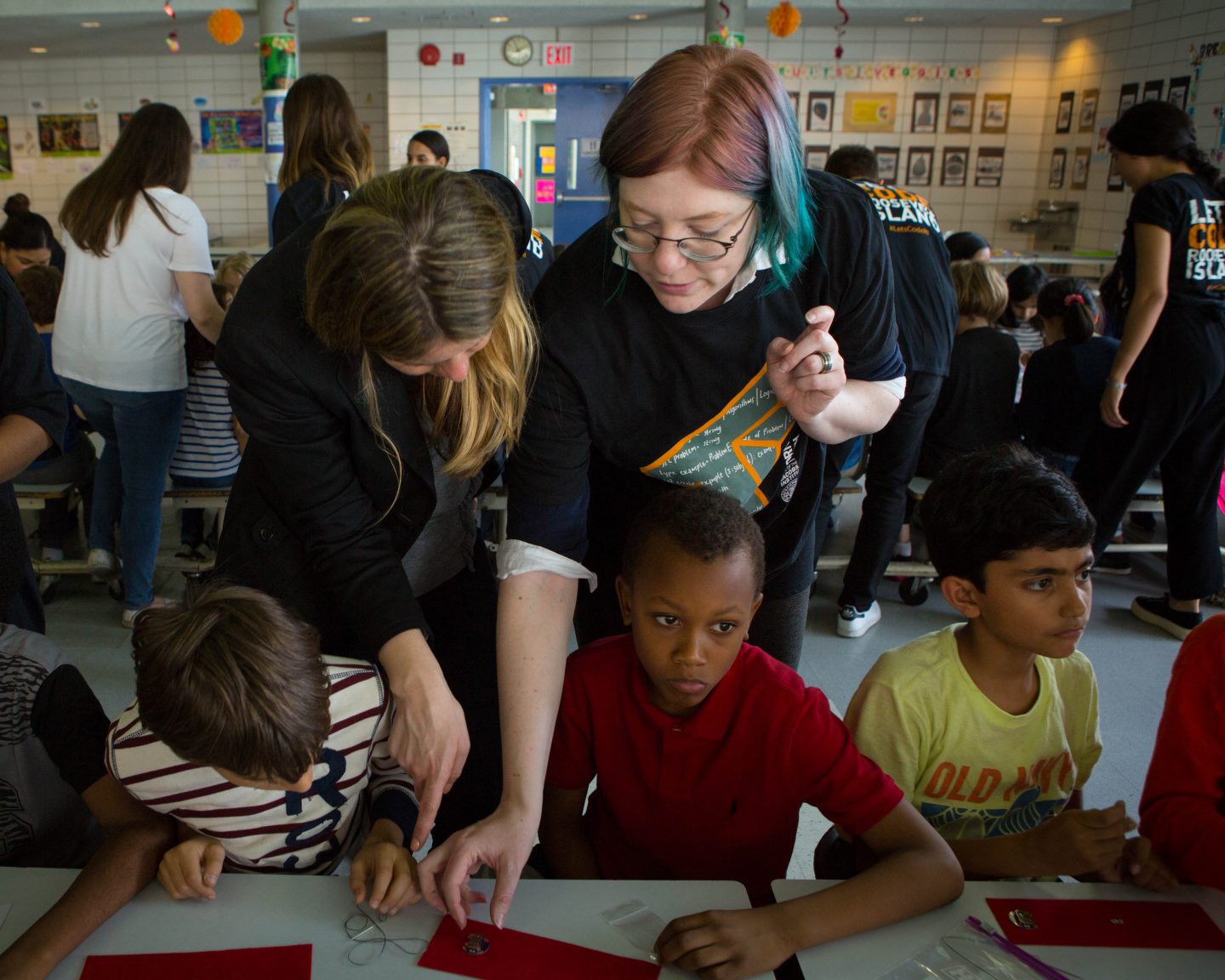
It’s a cloudy Tuesday morning, and PS/IS 217 third grade teacher Stephanie Ditaranto is turning her class into a human computer. On the carpet in front of her, 27 kids clap, cheer, or groan in unison as she holds up playing cards pulled randomly from a deck in her lap. With each card, the kids must run through a set of rules to see what their response should be.
The cacophony is all part of a new curriculum designed to bring computer science concepts into every grade at PS/IS 217, starting in kindergarten and stretching through middle school. Teachers are implementing the lessons with the help of a pilot program offered by the city’s Computer Science for All (CS4All) initiative, as well as hands-on instructional support from Cornell Tech.
The curriculum also puts the Island’s public school at the forefront of a national effort to better incorporate science and technology into the classroom, and positions the school as a potential model for how computer science is taught at the elementary-school level citywide.
“It’s really cool being able to teach computer science to the younger kids and get them excited about it,” says Ditaranto, “And to show them that this is something you can be good at, and something you could have a future in if you really want.”
Coding for All
Announced in 2015, CS4All is a 10-year initiative to bring computer science instruction to all New York City public school students by partnering with private and nonprofit organizations.
In June, PS/IS 217 was one of 11 elementary schools selected from more than 100 applicants for the city’s Elementary School Computer Science (SEP Jr) pilot program. The program provides a computer science curriculum for kindergarten through fifth grade, along with ongoing teacher training and teaching materials. How each school incorporates the program is largely left to the school’s administration to decide.
For PS/IS 217, winning a seat in the SEP Jr program created an opportunity to build on its partnership with Cornell Tech, which adopted the school as part of the agreement to build a new campus on the Island. In September, the school welcomed Meg Ray, a teacher-in-residence hired by Cornell Tech to provide hands-on training to the school’s teachers.
Funded through a three-year grant by the Siegel Family Endowment, Ray spends one day a week at PS/IS 217 working with teachers to incorporate the SEP Jr curriculum, and to adapt lessons to the needs of different students.
“I was a teacher and I know how hard it is to have someone from the outside come in and say, ‘Hey, so I know you just met me but I want to co-teach with you in your classroom,’” says Ray. A former computer science and special education teacher in New York City, Ray is currently on the writing committee for the national K-12 Computer Science standards. “The teachers here have been so warm and welcoming and really engaged in the process. It’s a new subject area for some of them, and you can see that they want to do it right.”
Real World Lessons
While the thought of teaching elementary kids to code may conjure images of students sitting in front of computer screens tapping keys, in fact, many of the lessons take place without any computer at all.
“You don’t start teaching math in high school and start with algebra,” says Ray. “Computer science is the same way. We’re not starting with programming right away. We’re starting with basic concepts that they’ll build on.” In the lower grades, many of the lessons are about thinking like a computer programmer: following steps, sorting, and debugging problems.
Ray recounts a recent lesson in a kindergarten class in which the teachers gave the students marshmallows and popsicle sticks and tasked them with building a tower. “We gave them [these materials] knowing they would have a hard time working with them. When their structure fell over, the kids got excited at having found a ‘bug’ in their structure, and they would try again. We purposely put them in a frustrating situation so a teacher could help coach them through that frustration.”
Students also spend time at the computer, playing games and solving puzzles that lay the groundwork for writing code. Later in the school year, students in higher grades will begin working with programmable robots.
Although the SEP Jr program is designed for the elementary grades, Diane Levitt, senior director of K-12 education at Cornell Tech, says the Teacher-in-Residence program will extend through middle school as well, expanding the curriculum to all grades.
Teaching Model
Meg Ray talks with PS/IS 217
kindergarteners.
While PS/IS 217 is far from being the only New York City school working to incorporate a computer science curriculum, Levitt believes it’s one of the schools pushing the envelope the furthest.
“The leadership of [PS/IS 217] have 100 percent bought into the idea that this matters,” says Levitt. “There are very few schools in the city like that. A lot of teachers who want to teach computer science are fighting with their principals to do it. PS/IS 217 doesn’t have that problem. They have set an expectation that every [teacher] will integrate computer science into their class. That is highly unusual. I just think it shows a remarkable growth mindset at the school. I think that’s a difference in how you see SEP Jr implemented here.”
Levitt also sees the Teacher-in-Residence (TIR) program as a key ingredient in the school’s future success. She believes that having someone who can serve as an internal support in the school – during school hours – helps foster a sense of ownership with the teachers. “After-hours staff development isn’t as practical for teachers who have already put in a lot of time and energy. That’s why we realized that putting someone in the building (where kids and teachers are) is, we think, the best strategy.”
Levitt says the TIR program continues to be a work in progress. According to Levitt, a research agreement with the Department of Education requires Cornell Tech to regularly survey teachers to see what is effective and what isn’t. “We have very little research telling us how to teach computer science to elementary kids. And we all have limited resources so we need to make the best use of our time and money,” says Levitt. “It’s in the interest of our funder that we share what we learn with the rest of the city. In that sense, 217 will be a model for the city.”
Future Partners
With Cornell Tech’s Roosevelt Island campus scheduled to open in the fall of 2017, Levitt says she’s looking forward to deepening the relationship between the two schools.
“Once [students] can just walk down the street to our campus, I think there’s going to be a lot more of them learning in our space and us learning in their space,” predicts Levitt. “It’s going to feel more like one classroom.”
Levitt acknowledges that the university’s relationship with PS/IS 217 got off to a rocky start three years ago, but she says the two schools have managed to create a strong partnership. “We were like an arranged marriage that first year. Since then we have built such an incredible, trusting relationship. Luckily we hung in there with each other and met frequently.”
In addition to the TIR program, Cornell Tech hosts several engineering and coding events throughout the school year. On a recent Friday, Cornell Tech graduate students hosted an event for middle school students, teaching them how to create electrical circuits using copper tape, cell batteries, and LED lights, and then helping them create their own Halloween decorations. In the spring, fourth graders will visit Cornell Tech’s Maker Studio in Chelsea.
Levitt says there’s much more to come. “We really want to make what happens between Cornell Tech and the 217 middle school extra special. All these skills you build in kindergarten through fifth grade get real when you enter middle school. Writing code becomes more possible. We’re going to do great work in the whole school, but I really feel we’re going to be able to do some things at the middle school that no one else is doing in New York. And I’m super-excited about that.
“I love working with this community. It’s not always easy, but it’s rewarding. There are people in this community holding our feet to the fire – as they should be. There are a lot of watchful eyes making sure we do the right thing by that school.”





